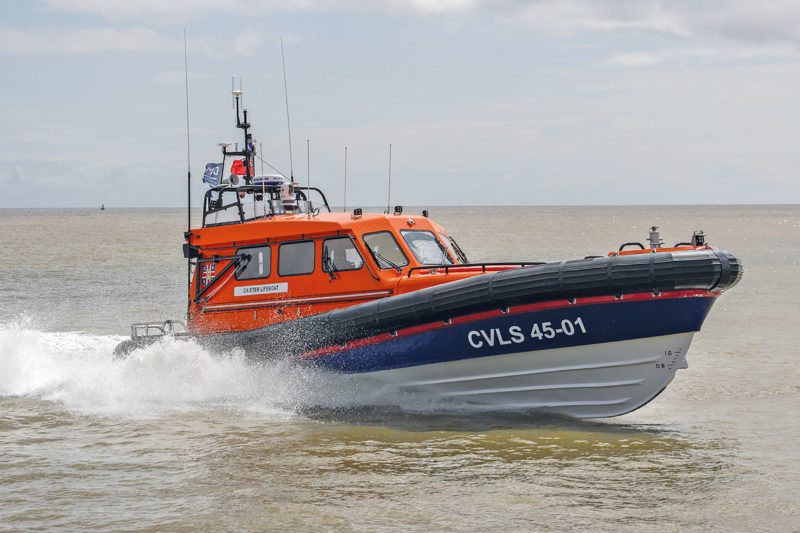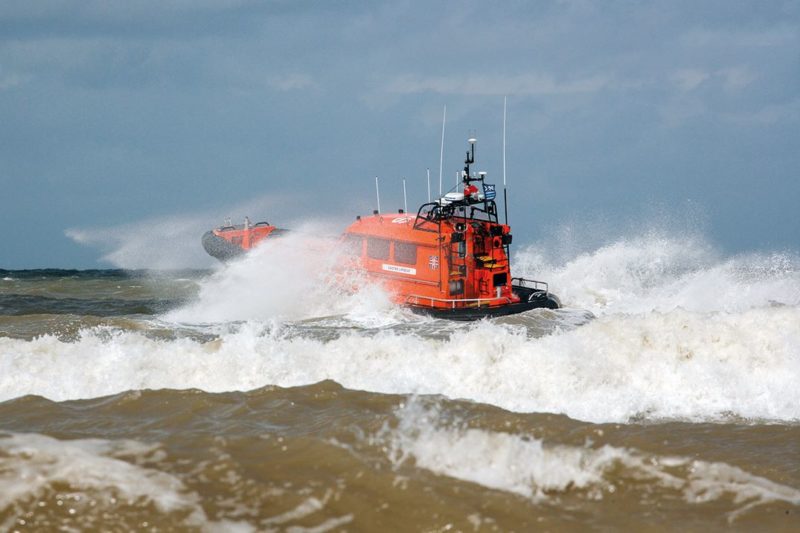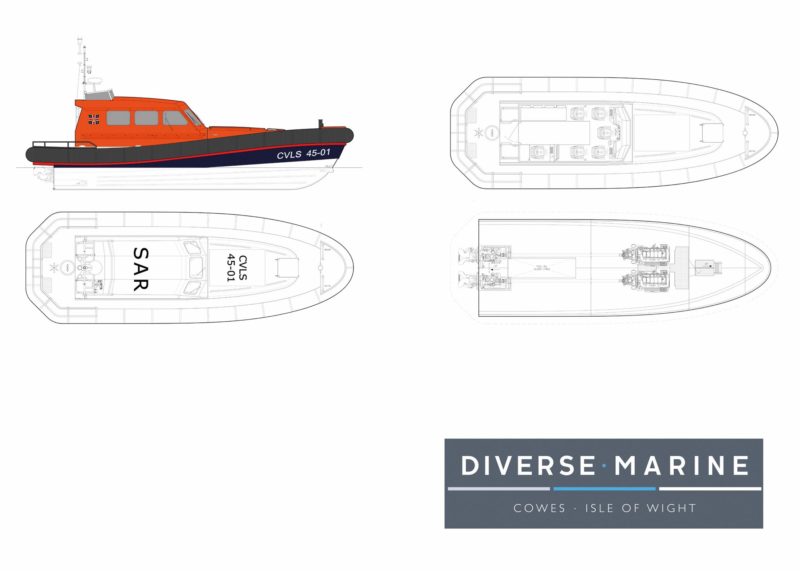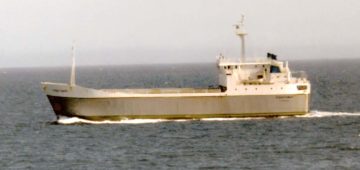
There are over 50 independent lifeboat organisations that operate along the coastline and on inland waterways across England, Wales, Scotland, and Northern Ireland. These independent lifeboats are run primarily, if not entirely, by volunteers, and funded by local donations. In 2022 The National Independent Lifeboat Association (NILA) was formed to promote and support these independent lifeboat organisations.
One such independent lifeboat operation is Caister Lifeboat, which can trace its history back to 1794 when a Beach Company was formed to watch over the growing local fishing fleet. Caister, full name Caister-on-Sea and, formerly, Caister-next-Yarmouth, is a large village in Norfolk, England, United Kingdom and is situated less than 3 miles from Great Yarmouth. It is a seaside resort and busy holiday destination on what is known as the Golden Mile, with its main attraction being the sandy Georgian Beach. It is home to Great Yarmouth racecourse and was also served by railway until 1959. Caister’s history dates to Roman times when a fort was built around AD 200.
With this in mind, it is no surprise that the name Caister derives from the Anglo-Saxon word ceaster meaning Roman fort. Looking back to the 1800s, the East Anglian coastline benefitted from the provision of lifeboats from 1845 and in 1857 the RNLI took over responsibility for these with a second vessel, The Boys, being allocated to Caister.
A new lifeboat, the James Pearce, was later gifted to Caister by the Birmingham Lifeboat Fund. Powered by 14 oars, the vessel was renamed Covent Garden in 1878. The Beauchamp joined the station in January 1892 but on 13th November 1901 she went out on a fateful mission that resulted in the tragic loss of 8 crewmen in abysmal conditions. The Beauchamp was not returned to operational condition, being replaced by the Nancy Lucy in June 1903. In 1941 the first motor powered lifeboat, the Jose Neville, was followed by a brand-new Oakley Class lifeboat in 1964, the Royal Thames. Sadly, on 17th October 1969, this very lifeboat was taken away from Caister as the RNLI had decided to close this vital station after 112 years in control of it. The Caister Volunteer Rescue Service (CVRS) was subsequently formed and received their first lifeboat, the ex-RNLI Liverpool Class vessel Shirley Jean Adye (formerly the RNLB W. Ross MacArthur) in August 1973 and she served until May 1991.
The purpose-built 38ft 6in 38-01 Bernard Matthews replaced the Liverpool Class lifeboat and served until 2004 when the baton was handed to the 11m long Dutch built 37-01 Bernard Matthews II on 29th August 2004, a Valentijn self-righting rigid inflatable craft. She entered service in October 2004. As the names suggest, Bernard Matthews was a major benefactor to the 1991 and 2004 lifeboats, and he joined forces with Comedian and TV Host Jim Davidson for the Bernard Matthews II. The CVLS was the first independent lifeboat operation in the country and, at the time of writing, operated 2 lifeboats, had 21 volunteer crew, had saved 392 lives and had annual operating costs of £250,000, which are reliant on fundraising and donations.
The Caister Lifeboat charity is made up of a board of 8 trustee directors, an operational crew and a team of volunteers who help run the office function, on-site shop, cafe and museum. None of the team is paid, so every penny of donations can be used to support the lifesaving work. The charity has been supported and visited by HRH Duke and Duchess of Cornwall, the Princess Royal and Princess Alexandra. In 2012, the year of the diamond jubilee of HM Queen Elizabeth II, Caister Lifeboat was invited to take part in the Pageant on the Thames, where the charity was presented with the Queen’s Award for Voluntary Service, the equivalent of an MBE.
A Sea of Change
On 21st December 2021, Diverse Marine Ltd. of Cowes, I.o.W, and Caister Volunteer Lifeboat Service Ltd. were pleased to announce that the two parties had signed a new vessel construction agreement for a first of class 14m Medina Class Lifeboat. After a competitive international tender process using a design from Walker Marine Design, the construction of the vessel at Cowes completed the evolutionary process that saw the original Medina Class Lifeboat built very close to the chosen build location over 35 years ago, at Souter’s Yard, Cowes, before the design was adopted by the Dutch who built the station’s current Lifeboat, the Bernard Matthews II.

The 14m self-righting Lifeboat would feature an aluminium hull, deck and coach roof together with a resiliently mounted GRP wheelhouse to reduce noise and vibration for the crew. The vessel had already commenced build with delivery set for 2022/23. The original Medina Class lifeboats consisted of three prototype Rigid Inflatable Boats (RIB) that were considered by the RNLI in the 1980s, the design being based on the Atlantic 21-class design of RIB. The craft were built by Souter Marine, Cowes (I.o.W) and William Osborne in Littlehampton and were 12.04m long with a 4.39m beam, speed of 28 knots and a complement of 4. The first two boats were funded by The Romsey Trust after an appeal from Lord Mountbatten in 1979, built in 1980/81 and named Mountbatten of Burma and Countess Mountbatten of Burma. These were trialled at Brighton/Littlehampton and Redcar/Blackpool/Dungeness respectively. The first was tested with both Sabre and Perkins engines whilst the second had Caterpillar engines. The third boat was funded by the RNLI, built in 1984, had an enclosed wheelhouse, was fitted with 285hp Caterpillar engines and trialled from the RNLI’s Poole HQ. Sold in 1989, the vessel later served The Marine Rescue Institute at Stonehaven, Kincardineshire, south of Aberdeen as MRI 42 David Stogdon MBE (named after the RNLI lifeboat designer) from around 2000. This youngest example of the Medina Class is known to survive having been advertised for sale on eBay in 2023 at Glasson Dock, Lancaster. The original example was converted to become the Swanage Diver at Swanage but the whereabouts of the second build was unconfirmed. Ironically, the Dutch Lifeboat service (KNRM) adopted the Medina Class design concept so the 11m long/4.10m beam/37 knot and Dutch-built Bernard Matthews II owes its existence to those RNLI trials. On 23rd March 2022 CVLS revealed plans to raise £1.6m for their new vessel at a ceremony at Great Yarmouth Town Hall.

During the occasion the CVLS flag was raised in front of the town hall and the crew took mayor Adrian Thompson and his wife, Jenny, for a cruise along the River Yare and out into the North Sea before heading back to Skippers Walk in Caister where the lifeboat station is. This kicked off the Keep the Boat Afloat fundraising campaign, part of the £2.5 million investment to upgrade and maintain lifesaving capabilities at Caister. Richard Thurlow, a senior crewmember at the Lifeboat Station, has worked closely with coxswain Guy Gibson on the new boat design and, with his brother, sister and family, hoped to raise funds to name the new lifeboat after their mother, Annette Gibson, a former nurse who passed away in 2018 but had made a tremendous contribution to the CVLS charity over the years.
The tradition is to give naming rights to the biggest single benefactor to a new boat fund raising appeal. The fundraising effort was again backed by long term celebrity supporter and charity patron, Jim Davidson, OBE. Indeed, Jim pledged to raise £20,000 by putting on a show at the Britannia Pier Theatre in April 2023. The money was to be donated through the Annette Thurlow Appeal, the memorial fund set up by former coxswain Dick Thurlow and Richard, Aaron, and Heidi.
The Keep the Boat Afloat campaign allowed people to put their names within the boat’s identifying CVLS 45-01 characters on the hull, in a similar way to a campaign run by the RNLI. The Bernard Matthews II was offered for sale on eBay for £300,000-£400,000 in February 2022, complete with the carriage and tractor. It shouldn’t be forgotten that, although housed in a boathouse, the lifeboats were/are launched from a wheeled, now tracked, carriage that goes across the beach and into the sea. Most recently this has been propelled/hauled by a 15t/245hp Caterpillar Challenger 65C tractor crawler delivered in 1994 and listed for sale with the Bernard Matthews II. The station also has a 5m long/35 knot inshore lifeboat (rigid inflatable), the Fred Dyble II, which was commissioned in 2019 and is also launched from a wheeled carriage propelled/hauled by an ex-RNLI 19t/105hp Talus tractor crawler. This machine was previously based at RNLI Peel on the IoM. The new £250,000 tractor, a Caterpillar MT845E (20t/450hp) for the new lifeboat and launch carriage was converted for CVLS use (full marinisation) by Marineweld in North Walsham and the new carriage was built by Seatrax UK Ltd. in Great Yarmouth.
From River to Ocean
The 21st century first-build of the Medina Class lifeboat was launched into her namesake river as Build No. DM-2305 on 4th April 2023 having had the keel laid on 1st February 2022. Builder, Cowes based Diverse Marine Ltd., evolved from South Boats I.o.W in July 2018 when the new company’s Directors acquired the assets and equipment of their former employers, South Boats I.o.W., securing the employment of 20 staff on the site at Medina Yard, Cowes. The company later purchased the freehold of the 12-acre Medina Yard and Medina Village waterfront site in October 2022 from the Peter Harrison Trust. Diverse Marine specialises in the construction of a varied fleet of workboats, primarily offshore wind crew transfer vessels but also search and rescue craft, crew boats, workboats and more. Notable deliveries have included the Seacat Columbia in 2022, the first of class BARTech30 for Seacat Services, and the amphibious CRC Walrus. Both were subjects of the Newbuild of the Month series in December 2022 and June 2023 respectively.
Following the self-righting test on 5th April 2023 and initial trials, 45-01 was publicly unveiled by Diverse Marine at Seawork in June 2023. The lifeboat had performed above expectations, achieving well over the contract speed at 37.5 knots. Nusrat Ghani, Minister of State at His Majesty’s Government’s Department for Business and Trade visited the vessel during Seawork and spoke to Diverse Marine about the build programme.
On Sunday 6th August the new state-of-the-art £1.6 million lifeboat made her debut at Caister Lifeboat Day, running in tandem with the outgoing Bernard Matthews II. The newbuild also visited Lowestoft for trials with the new bespoke boat carriage before returning to Diverse Marine for final testing. The vessel is designed for launch and recovery from/to a beach so has a minimal draught and the Hamilton HJ364 waterjet propulsion system is located in the raked stern profile so remains clear of the beach etc during launch/recovery, particularly in rough conditions.
Readers may recognise the design as being similar to the RNLI’s Shannon Class of lifeboats, which carry the 13-xx fleet numbers and are allocated to afloat, slipway and beach launch stations. For optimum weight distribution the Scania DI13 077M engines in the Medina Class are located forward of midships, allowing direct access to the engine room from a hatch in the deckhouse forward of the wheelhouse. The main engines offer a total output of 1,104kW. It is of course essential to keep the engines low down in the hull and to incorporate a wheelhouse that is buoyant to assist the self-righting capabilities of the lifeboat. Air vents/intakes all close as the lifeboat rolls, via a pendulum system, and re-open once upright again.
The engines will go to idle speed in a capsize and are set up to prevent oil and oil mist from entering air intakes or contacting hot surfaces in the event of a 360-degree roll. The fully air-conditioned wheelhouse layout is designed for up to six crew, all with designated AllSalt Maritime SHOXS 2000 seats. Configuration is for a central helm station forward, a seat either side (so 3 across), a navigation station aft to starboard, two further seats in the rear of the cabin plus a dedicated space for a stretcher along the portside between the two seat positions. There is also a below deck cabin for survivors. The twin helm stations (in the wheelhouse and on the flying bridge above the rear of the cabin) feature Hamilton Jet’s AVX control system and Jet-Anchor functionality for station keeping. A comprehensive navigation and communications suite is supplied by Boat Electrics and Electronics Ltd. As is often the way with such first off projects, the delivery and commissioning of the new Caister Lifeboat was deferred from 2023 into 2024 due to delays with some stages of the overall process such as completing and trialling the new boat cradle etc.
The lifeboat will need to be lifted out of the water and tested with the cradle before final on-site trials can be completed. Confirmation of delivery date and chosen name for the vessel will follow but everyone involved is to be congratulated on this tremendous achievement, all made possible by kindness, determination, skill, dedication and generosity.


-
Special thanks must go to Simon Thomson of Diverse Marine Ltd. and Steve Milner and Andrew Turner at Caister Lifeboat for their invaluable help with information, images, and diagrams.
Technical Specifications
| Designer | Walker Marine Design Ltd., Hamble-le-Rice, Hampshire |
| Builder | Diverse Marine Ltd, Cowes, I.o.Wight |
| Build number | DM-2305 |
| Owner/Operator | www.caisterlifeboat.org.uk, The Lifeboat Station, Tan Lane, Caister-on-Sea, Norfolk, NR30 5DJ |
| Order date | 21/12/21 |
| Keel Laid | 1st February 2022 |
| Launched | 4th April 2023 |
| Delivery | Early 2024 once Caister Lifeboat Station had the new lifeboat carriage ready |
| I.D Number | 45-01 |
| Name | TBC |
| Construction Material | Aluminium |
| Superstructure Mounting | Resilient GRP Wheelhouse |
| Classification | MCA Workboat Code Category 2, 60nm, MCA Rescue Boat Code |
| Length Overall | 14.03m |
| Hull Length | 13.40m |
| Length at Waterline | 11.90m |
| Beam (Maximum) | 4.76m |
| Maximum Draught | 0.90m |
| Maximum Displacement | 17.90m |
| Load Line Length | 11.70m |
| Fuel Oil Capacity | 2,000 litres |
| Fresh Water Capacity | 10 litres |
| Main Engines | 2x Scania DI13 077M |
| Gearboxes | 2x Twin Disc MGX5114SC |
| Propulsion | 2x Hamilton HJ364 Waterjets |
| Maximum Speed | 37.5 knots (100% MCR) |
| Service Speed | 29 knots (85% MCR) |
| Crew | 4-6 |
| Survivor Capacity | 4 |
| Flag | UK |
| Port of Registry | Great Yarmouth (TBC) |
| Main Radar | Furuno DRS4DNXT |
| AIS | Furuno FA170 |
| Satellite Compass | Furuno SC70 |
| GPS Compass | Furuno SCX20 |
| Echosounder | 1 x Furuno BBDS1 Dual |
| Direction Finder | 1 x Rhotheta RT-300 |
| Autopilot | Simrad AP70 |
| Thermal Camera | Flir M400XR |
| Searchlight | Luminell S1 LED |




Comments
Sorry, comments are closed for this item